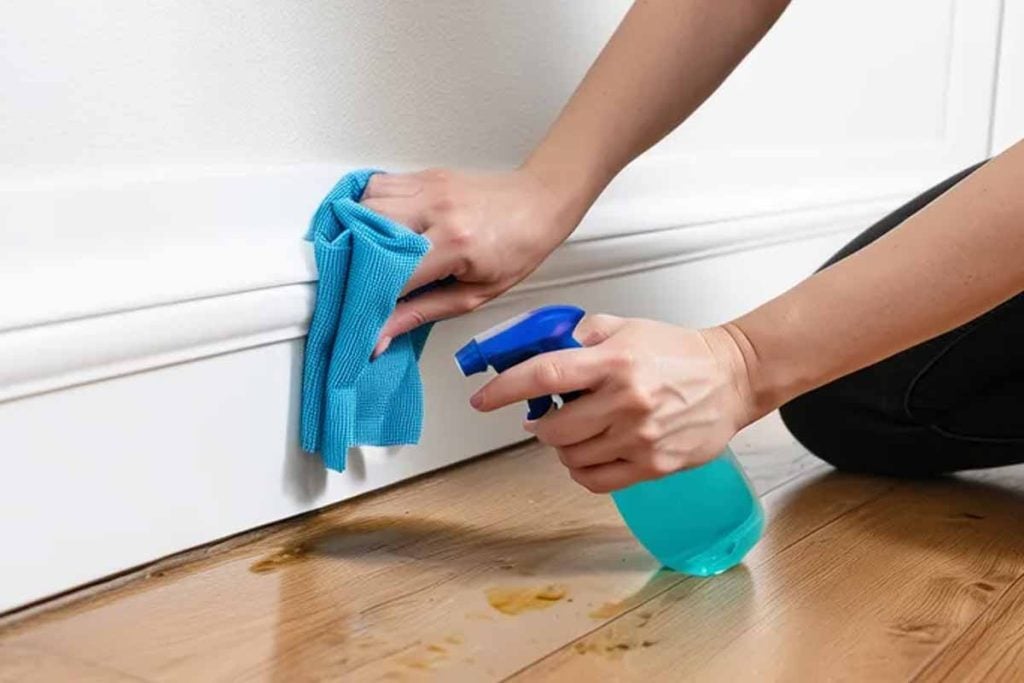Dust loves edges, yet one small laundry trick turns trim into a no-stick zone. With a few quick passes, surfaces feel clean longer and look freshly painted. The secret also tackles stubborn lint and pet hair, which is why many pros swear by it. Because the fix reduces static, it stops debris from boomeranging back. Better yet, you likely already own it. Used right, your baseboards stay brighter, with less effort, and your rooms feel lighter.
Why static makes dust cling to baseboards
Dry air builds static, so dust and hair latch onto trim like magnets. Dryer sheets contain softeners with positively charged ions that neutralize that charge. Their slightly textured weave also grabs particles fast, which helps on grooves and profiles. Many cleaners praise this because results are instant.
You’ll see the tip everywhere on TikTok, and the praise isn’t hype. Wipe once to lift dust, then swipe again to leave the anti-static finish. Because the charge gets neutralized, dust resettles more slowly. Expect a longer-lasting clean on TVs, window sills, and baseboards too.
The sheet’s uses go beyond dust. According to home hacks, the same product even loosens burnt-on food in pans. That versatility explains why it’s a staple in busy households. It handles pet hair on upholstery, helps with blinds, and shines on electronics when used gently and dry.
Step-by-step method that keeps dust away longer
Start small jobs with a fresh dryer sheet. Used sheets lose anti-static power. Work from top to bottom so loosened dust doesn’t fall on cleaned areas. Glide along profiles, then press lightly into corners and seams. If an edge looks fuzzy, switch to a new sheet for better pickup on baseboards.
For very dirty trim, add a quick wash cycle. First, wipe with a barely damp microfiber to gather most grime. Next, scrub stains using a cloth and mild soapy water. Then, towel everything dry so moisture doesn’t draw dust. Finally, sweep each run with a clean dryer sheet.
Heavy buildup needs patience, not pressure. Short overlapping strokes beat hard scrubbing, which can dull paint. Lift the cloth often to rinse and reload suds. After drying, that final dryer-sheet pass leaves the anti-static finish behind. You’ll see less dust cling for a good while after.
Practical tips, surfaces, and smart timing
Know your material. Painted wood, MDF, and PVC molding all respond well to light passes. Test a small, hidden spot if the finish is matte or specialty. Keep sheets dry on electronics and screens. Because static loves low humidity, aim sessions for drier days to guard baseboards.
Adopt an easy rhythm. Weekly quick wipes maintain a low-dust baseline, while monthly deep cleans reset everything. Move furniture a little to catch the dust lines hiding at floor edges. Use a hand vac on the floor right after wiping so loosened bits don’t rebound onto the trim.
Avoid common errors. Don’t oversoak cloths; water tracks attract dust. Don’t reuse dryer sheets for this task. And don’t skip the drying step before the final pass. Gentle pressure is enough. The sheet’s texture and ions do the work, not elbow grease, which keeps paint crisp.
Eco-minded ways to care for baseboards
Prefer fewer disposables? Some people avoid dryer sheets because of waste and residue on clothes and dryers. If you keep liquid fabric softener, harness its anti-static benefit instead. Swish a drop into a bowl of water, dampen a microfiber, and dust trim without over-wetting baseboards.
Anti-static spray is another option. Formulations made for clothing, carpets, and furniture work on trim as well. Several are designed to leave no residue. Mist the spray onto your cloth, not the wall, then wipe. That indirect method prevents spotting, gives even coverage, and controls scent strength.
Choose what fits your routine. If you already use dryer sheets, reserve a fresh one for cleaning sessions. If you don’t, the diluted softener or a residue-free spray delivers the same static control. Either way, the goal stays the same: neutralize the charge so dust won’t cling.
Mistakes, quick fixes, and bonus gains
Using a spent sheet is the top mistake. It won’t counter static, so dust reappears fast. Another error is pushing hard on profiles, which scuffs paint. Keep strokes light and frequent instead. After the final sweep, a soft glow returns and your baseboards look newly detailed.
Missed a week? Do a two-stage rescue. First, the damp microfiber gathers grit. Second, gentle soap lifts scuffs. Dry well, then apply the anti-static pass. That last step is the difference-maker; dust won’t rush back right away, so your cleaning window stretches and rooms stay calmer.
Enjoy side benefits as you go. Edges trap allergens; removing them helps air feel fresher. Pet owners see fewer tumbleweeds around door casings. Media areas look sharper because screens and soundbars stop wearing fuzzy halos. Small effort, strong payoff, and a tidy frame for every wall.
Small laundry tweaks that keep your trim dust-free longer
Quick routines stick when results are visible. A fresh dryer sheet or anti-static cloth turns trim into a low-dust zone within minutes. Because the finish reduces cling, upkeep shrinks to light touch-ups. Use the method that fits your habits, and your baseboards will keep that just-cleaned look.
